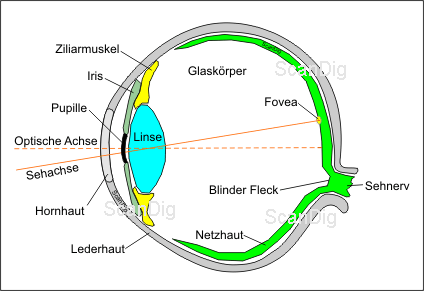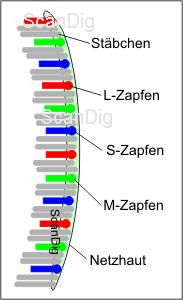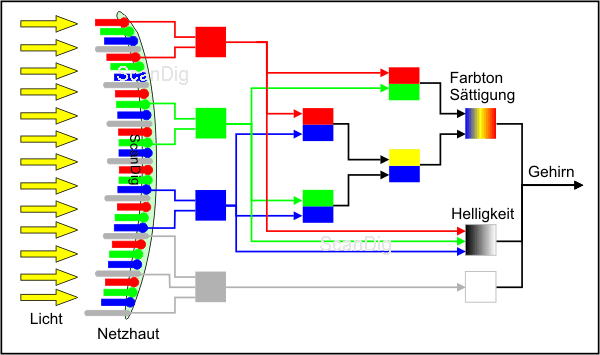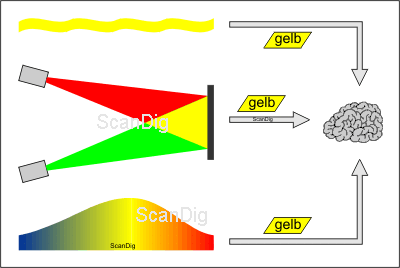Colour perception
In order to understand the functionality of a digital camera or a film scanner it is important to occupy yourself with the human perception. Finally each photographer and everybody who digitizes films has the aim, to achieve the same effect with one's digital camera or scanner as the human eye does. In other words it is the objective of each digital camera manufacturer to imitate the process of the human colour perception as perfect as possible. The better the technical imitation of the human colour vision is the closer to reality the images are, which a digital camera delivers as a copy of the reality.
The followint chapters explain which phisical and psychological processes run in a human beeing at the colour perception. It is especially important to get to know the human camera, i.e. the eye, and to understand how it works. If you have understood these processes you look quite differently out of your pupils and through the viewfinder of your digital camera.
What does colour perception mean?
Under the term colour perception one comprehends a physiological and psychological procedure at the human being, at which colour information are received and processed. The physiology describes the physical and biochemical process in the human eye when color stimuli arrive in the human eye. The psychology describes the treatment of the colour signals in the human brain. Two examples shall point out these two procedures:
Example 1: Two people which sit vis-a-vis to each other in a train exert different phyisical stimuli to each other which are received by different sens organs. The eye receives light signals, the ear gets acoustical signals, the nose might (maybe) smell the other person, and if it is not a first class compartment you even get touched by the person in vis-a-vis you again and again. These described signals are physical information, which also can be detected with measurement instruments. Our brain processes these signals to an overall picture of the counterpart: A man may be blended completely from the optical signals of an attractive woman, while he is completely frightened from her smoke smell. The brain evaluates the phyiscal signals and compares them with known, stored similarities; this process is only psychological, at which each person decides and classifies on his own way.
Example 2: A bonfire emits physical colour, warmness and acoustical signal to the people sitting around it, who perceive them with their human sense organs. The brain processes these signals and identifies the bonfire, with which a comfortable well-beeing is associated. If the bonfire gets out of control and even a wildfire threatens to happen, the human sense organs still receive the same physical signals, which, however, are interpreted differently by various humans: Whereas at an anxious human a panic reaction may be caused, at a adventurous human a fantastic thrill may arise. Here the individual psychology of a human plays a role.
In the following we concentrate on the human eye, which can receive colour stimuli and forward them to the brain for the processing. This subprocess of all human perception capabilities we call colour perception. In order to distinguish once more between the physiological and the psychological process at the colour perception we contemplate a blue and a red colour mark on a faucet. Physically we speak about two light signals, one in the field of the wave length 450 nm and one in the wave length field of 750 nm. Both colour stimuli are detected by the human eye within a complicated biochemical process and then forwarded to the brain. The brain compares the two colour signals with well-known examples and automatically assigns the colour blue to COLD and the colour red to WARM. We have learned that as a child and associates these colours with water and fire. Let us summarize:
While colour tones can be described as a physical size, the human perception is a complicated, individual, physiological and psychological process, which may lead to a different result from human to human.
Structure of the human eye
The human eye is a sense organ which reacts on electromagnetic rays in the wavelength range 380-780 nm. It is that range we designate as visible light. Since the eye is the most important sense organ of the human being it is correspondently protected. The eye is embedded in the eyeholes of the skull, the bones protect it from shocks. The eyelid closes reflexively as soon as something comes in the direction of the eye. And as soon as a tiny piece of dust gets into the eye it will be flushed out with a lot of tear fluid.

The eye itself is a complex part which consists of many skins, muscles, nerves and colour receptors. It is surrounded by the sclera, which protects the eye and which muscles twist the eyeball within the eyehole. At the front side the sklera is interrupted by the transparent callus. Through the callus and the pupil the light gets into the interior of the eye. The pupil is the interior part of the iris; it changes its size by the iris muscles. By this mechanism the incidence of light can be controlled with muscles (compare the aperture at a camera). Directly behind the pupil there is the eye lense, which is accomodated by ciliary muscles. With this lense the eye focuses and the focal length is set. This muscle is relaxed at slepp or at a view into the far distance. When reading a book the so called accomodation takes place: The ciliary muscle ring contracts the lense so that it focusses to the near.
The eye lense breaks the in coming light sources and projects them through the bowly glass body to the retina of the eye. The retina is the light sensitive layer, which colour receptors (pins and rods) detect the colours and the brightness by a complicated biochemical process. They transfer light signals into electrical signals which are forwarded to the brain via the optic nerve. Thus the human eye somehow works like a camera: The pupil corresponds to the aperture, the eye lense corresponds to the lense, the retina corresponds to the film or the CCD chip. The brain carries out the signal processing, which is done by the integrated processor within a digital camera.
At this point, where the optic nerve exits the eye there are no sense cells. It is the so called blind spot, at which no vision can be done, thus a truly blind spot inside the eye. Another important point on tthe retina is the Fovea. The Fovea is exactly at that position, at which a light ray, which runs vertically through the pupil hits the retina. The Fovea is the point of the best and sharpest vision. It is also called yellow spot.
Finally a small appendix: Basically one should not say that the human eye works like a camera. Much more a camera imitates the human eye. But some photographer knows the interior and functionality of his camera much better than his eye...
Receptors - rods and cones
As described in the previous chapter the retina is the light sensitive layer in the interior of the eye. On it there are about 100 millions of light sensitive sense cell, the so called photo receptors. These receptors are classified in rods and cones. The cones measure the lightness of the incoming light, while the cones measure the colours.

Rods are about 1000 times more sensitive than cones. The greater sensitivity comes from the larger surface and the higher rhodopsin content (light sensitive colorant). They only measure the illuminance of the incoming light, so they deliver only a black and white image. Due to their high sensitivity the rods also work at night and deliver simple B/W picture to the brain even with the weekest light. Alread at half-light at the rods a saturation happens, so that they only deliver a bright white as illuminance information. Thus under bright light circumstances the rods are quite useless, since they are too sensitive. At daylight the cones do their duty: There are three kinds of cones, red sensitive L-cones (L stands for Long, long wavelength), green sensitive M-cones (M stands for Medium, medium wavelength) and blue sensitive S-cones (S stands for Short, short wavelength).
From the measurements of the L-, M- and S-cones the brain creates a colour image, which we know from our daily life. Thus the cones have a low sensitivity, so that they work only at good light, i.e. a specific minimum amount of photones is neccessary in order to activate the cones. At dawn or at night their functionality reduces significantly, so that the more sensitive rods have to help out. Since rods are only sensitive to illuminance the colour vision decreases at dawn. That's why the human beings cannot recognize colors at night any more, and all cats are grey at night.
From the approx. 130 millions photo receptors on the retina there are 95% rods, which are sensitive to illuminance, and only 5% cones, which are sensitive to colours. The different kinds of cones are not equally split (the blue sensitive S-cones have the smallest part). Rods and cones on the retina are not spread equally, much more the cones concentrate in the area of the Fovea. At this so called yellow spot the human eye can see most sharply. The cone density decreases from that point rapidly. At the edge of the vision field there are hardly cones any more. Since during the day the the cones work and during the night the rods work, during the day one can see most sharply in the area of the Fovea, whereas at night one can see better in the exterior areas with the rods. Because of that reason many people have a less sharp vision at night than at day. And some stars can be recognized at night only if you don't look at them directly.
The existence of the yellow spot can be verified by a simple experiment: If you look at the screen and focus one word firmly, you can read only a few words around it, if we don't move our eyes. Everything which is outside of a small circle is not in the focus and we recognize it only as writing, but we cannot read information.
On the retina of of the eye there are different kind of photo receptors: light sensitive rods and colour sensitive cones.
Since the human colour vision is based on the described three cone variants we are designated as Trichromats. There are animals which have a forth ultra violet sensitive cone type on their retina; such animals are designated as Tetrachromats. Their vision capability exceeds the human limit of approx. 380 nm in the ultra violet area.
10% of all men and 1% of all woman have a colour ametropia, which most common forming is the red-green blindness. This is caused by a misfunction of the red or green sensitive cones. Since such humans can see colours only with two types of cones they are designated as Dichromats. Animals which have only one cone type available are called Monochromats. Animals which cannot see colours at all are designated as Achromats. At humas a complete colour blindness exists if all three cone types fail. Such humans can only see in black&white.
Signal processing in the brain or in the retina, respectively
With the information from the previous chapter about the retina of the human eye and about the rods and cones on it you can imagine the colour vision quite simply: The rods measure the brightness at night, the cones measure the red-, green- and blue-part of the incoming light. They transfer their light signals into an electric current which si forwarded to the brain through the optic nerve. In the brain the signal processing to a colour image or a black&white image is done. So we know the signal processing in a digital camera, where the brain corresponds to the processor and the rods and cones to the photo diodes on the CCD chip. But the eye is a complicated organ, which the technique can only imitade rudimentally:
The approx. 130 millions rods and cones on the retina don't forward their information directly to the brain, but before a complicated interconnection and signal processing is done. In contrast to the 130 million photo receptors there are only about 1 million ganglion cells, which are directly connected to the optical nerve, which leads to the brain. Between the photo receptors and the ganglion cells there is a complex layer inside the retina, which contains bipolar cells (interconnection of photo receptors), horizontal cells (crosslinks and interconnection of photo receptors) and Amakrin cells (crosslinks and interconnection of ganglion cells), which do different interconnections of the photo receptors.
Why this complex interconnection of the photo receptors? In the area of the yellow spot (Fovea), for example, the signals of a one optic cell are forwarded to a ganglion cell directly through a bipolar cell 1:1. This leads to an extremely high sensitivity. That's why this point is the point of the sharpest vision capability. In the exterior areas of the retina hundreds of optic cells are interconnected over bipolar cells and horizontal cells to a ganglion cell. Because of this interconnection a kind of signal amplification takes place on the cost of detail resolution, and at lowest light situations one still can see contours. Please, compare this procedure with the signal amplification in a digital camera, if the ISO value is increased.
How do colours and colour impressions arise in the brain? We have just learned that rods and cones do not simply forward their information to the brain, but that there is a complicated interconnection of the singular signals. The following figure shows the colour signal processing at daylight on a simple way.

Bright daylight hits on the retina. On the retina there are the grey rods as well as the red, green and blue cones. The three cone types are sensitive to the colours red, green and blue, whilst the rods only measure the illuminance. With the red and green colour information first a red-green-process takes place, i.e. the red and green colour information are computed to one colour tone. At this point it becomes clear, why one speaks about a red-green-blindness, if either the red or green cones do not work perfectly.
From the red and blue colour information a red-blue part is calculated, from the green and blue colour information an green-blue-part is computed. These two parts deliver the blue-yellow part. (Note: Analogously to the red-green-blindness there is also a yellow-blue-blindness, which, however, occurs very seldomly at humans.) Finally the red-green-part and the yellow-blue-part is transferred into a specific colour tone with a specific saturation. These two values then are forwarded to the brain. You recognize, that the brain saves a lot of "calculation time" by the preprocessing in the eye.
What about the illuminance? Parallel to the calculation of the colour tone an illumination calculation takes place, by composing the red-part and the green-part and the blue-part with each other. The illuminance is the third component, which is forwarded to the brain.
In the area right down at the bottom of the image there is additionally shown the signal processing in the rods. Above we have learned that the rods are extremely light sensitive and achieve their saturation at daylight. So the rods do not deliver illuminance differences at daylight any more, but deliver a saturated state, which is the brightest white, as illuminance information. With that information the brain of course cannot do a lot.

At night the signal processing in the retina looks different: In the previous chapter we have learned that the the light quantity is not sufficient at dark in order to stimulate the cones, i.e. the nomber of photones is too small in order to create the threshold curent. Thus the cones do not deliver a colour at night but only a dark black. With that information the brain cannot do anything, it is simply black, just nothing.
Therefore the small light quantity is sufficient in order to stimulate the rods, unless they achieve the saturation point of their measurement range. Thus the rods deliver the illuminance information at night, which is won from the cone computations at daylight. However, at dark the information about the colour tone and the saturation is missing from the cones. And this finally is the reason why we can recognize only grey tones at night and no colours.
At this point I want to note that at daylight the brain gets information about colour tone and saturation, and apart from them information about the illuminance.
This separation of the colour information in hue, saturation and brightness plays an important rolein the colour theory. Numerous colour models in the digital image editing are based on the separation of colours into three components. Colour models, which are constructed by the basic elements hue, saturation and illuminance thus imitate the human colour perception in a very realistic way and so are colour models which are very close the toe reality.
Finally I want to mention that the above described signal processing into the information hue, saturation and luminance are not the single signal processing steps in the retina of the human eye. There also a contrast increase for an augmentation of the sharpness impression takes place. And finally there are the well-known optic illusions with twhich the signal processing in the retina or in the brain, respectively, can be cheated or irritated purposefully.
Metamerism
We have learned in the previous chapter that there are three different kinds of photo receptors for the color vision on the retina of the human eye, namely cones which are sensitive to red, to green and to blue. If monochromatic red light (light of only one wavelength) with the wavelength 700 nm falls onto the retina only the red sensitive L cones are stimulated and the brain gets a clear signal. But what happens, if monochromatic yellow light with the wavelength 600 nm hits the retina? The both the red sensitive L cones and the green sensitive M cones are stimulated and the above descripted signal processing delivers the colour yellow to the brain (see upper part of the figure).

You don't get a yellow colour impression only if clear yellow light, i.e. monochromatic light with a wavelength of approx. 600 nm arrives on the retina, but also if both monochromatic red light with the wavelength 700 nm and monochromatic green light with the wavelength 500 nm hits the retina. Also with this light mixture the brain gets the same colour impression, since both the red sensitive and the green sensitive cones are stimulated (see middle part of the figure, where a red and a green spotlight create a yellow area on the focusing screen).
This example shows that at a human being a yellow colour impression can be created on different ways, both with monochromatic yellow light and as a mixture of monochromatic red and green light. If polychromatic light (light of different wavelengths) is used, an infinite nomber of combinations of spectral colors can be found, which again create a yellow colour impression (see lower part in the graphics). Thus the human is not able to determine the composition of light, i.e. to split light into its spectral colors. Light of different compositions can create an equal colour impression at the human being. This effect is called metamerism.
As metamerism the effect is designated that different colour spectra can create the same colour impression at a human.
The graphics above shall demonstrate exactly this effect: No matter if yellow light is in the form of a monochromatic spectral colour, for instance from a laser, or if a red and a green spot create a yellow area on the focusing screen by mixing the colours additively, or if a body emits a colour spectrum by an appropriate reflexion of the white sun light, which creates a yellow colour impression, it does not play a role for the brain. In any of the three cases the brain creates the same colour impression, no matter from which light source the yellow colour comes from.
So far to the theory. Which effect does the metamerism has for the practice and for our dayly life? Let us begin with something positive: Metamerism makes the reproduction of a huge colour spectrum on the basis of three basic colours possible. A computer screen creates each pixel with a red, a green and a blue tiny LED, which create more than 16 millions colours by variing their luminance. In theory one could also create these 16 millions colours with the same nomber of mini lamps. But fortunately for the human brain it does not matter, if a singla spot creates the yellow colour or if two spots mix the colours red and green in order to create a yellow spot. That is metamerism!
Another example, where metamerism is used, is the displaying of violet colors at a computer screen. Strictly speaking a computer monitor cannot show violet colours, since viloet light has a wavelenghth of approx. 360-380 nm, whereas blue light does not start before 380 nm. Anyway a violet colour impression is created by mixing some red light to a blue light source. In the colour spectrum this means, that very short-wave light is a mixture of short-wave blue light and long-wave red light. At the first glance this seems to be a paradox, but that is simply metamerism. Finally important is the colour impression and not the wavelengths of the ligth
A negative example: A lady buys a red skirt in a fashion boutique and finds also a suitable red blouse. In the fashion store, where numerous neon tubes create a good illuminance, the two colour tones match exactly to each other. But as soon as the lady tries this combination outside for the first time, when the sun shines brilliantly, she gets a huge shock, since the two red tones do not feat at all. Where does that colour change come from? Both cloths create a red colour impression, although they emit a different light spektrum. Under artificial light these differences are hardly to be seen, whilst they become extremely noticeable at natural daylight. The colour spectrum of both cloths shows a big metamerism, i.e. many spectral lines are almost identical, however, there are some differences, which can be seen only at a specific illumination.
One more example: Neon tubes emit a characteristic spectral line in the green area. The human eye has noe problem with that and simply ignores this spectral colour, or balances it automatically. However, a digital camera, which is set to sunlight but is used under neon light, is irritated by that characteristic green light so much that the images get a strong yellowness. A relief can be done by a white balance, which sets the camera to a lower colour temperature or especially on neon light.
For the practice metamerism means that colours have to be evaluated depending on the surrounding light. The comparison of two colorants only makes sense, if they are contemplated under the same light situation. There is so called standard light, which is given with the colour temperature of 5000 K for instance, which is suitable for contemplating and comparing of colours.
For the evaluation of colours the surrounding light plays an important role. An objetive evaluation is only possibla under standard light conditions.
Back to the index colour management
|